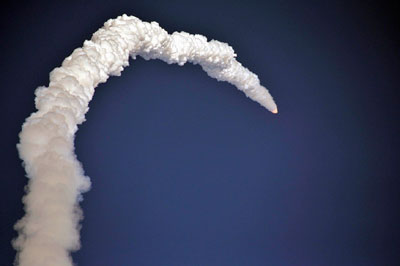 Sriharikota:
Sriharikota: The successful launch of India's heavier rocket - the geosynchronous satellite launch vehicle-D5 (GSLV-D5) - Sunday not only means the indigenous cryogenic engine is performing well but also would pave way for sizeable savings, the space agency's chief said Saturday.
"When GSLV-D5 succeeds in its mission Sunday, it means the Indian cryogenic stage/engine is performing well. It is a culmination of major indigenous technology development," Indian Space Research Organisation (ISRO) chairman K.Radhakrishnan.
In addition, the mission's success would not only pave way for ISRO to save launch costs paid to foreign space agencies but also to launch more communication satellites augmenting the transponder capacity to earn more revenue, he added.
Radhakrishnan said the country pays around $85-90 million or around Rs.500 crore as launch fee for sending up a 3.5 tonne communication satellites whereas the GSLV rocket costs around Rs.220 crore and the GSAT-14 that would go up Sunday evening costs around Rs.145 crore.
The ISRO can send smaller communication satellites - weighing around two tonnes - till such time it gets ready an advanced GSLV variant that can lug satellites weighing around four tonnes.
While that is for the future, Radhakrishnan said ISRO has lined up several satellite launches for the current GSLV rocket version.
"We will be launching satellites GSAT-6, 7A, 9 using GSLV. We will also be using this rocket for our second Chandrayaan mission and for the launch of GISAT," he said.
According to him, another communication satellite GSAT-15 will be launched using the Ariane rocket.
Other than the flight testing of cryogenic engine, 2014 will be an important year for ISRO.
Radhakrishnan noted that in September, the Mars Orbiter will be injected into the Mars orbit while the test flight of GSLV-Mark III version will also include a crew module for characterisation of re-entry from the space.
"The GSLV-Mark III experimental mission will be in April this year. The rocket will have a passive cryogenic stage/engine. The main purpose of the mission is to study the aerodynamics and stability of the rocket," he said.
He said the cryogenic engine for the next GSLV version will take around three years for being flight ready.
According to him, the next fiscal (April 2014-March 2015) would see ISRO launching three IRNSS (Indian Regional Navigational Satellite System) satellites taking the total to four and be ready for usage.
He said ISRO will also launch French satellite SPOT-7 along with four small satellites using its other rocket Polar Satellite Launch Vehicle (PSLV).
Radhakrishnan said ISRO plans to induct around 96 transponders (receivers and transmitters of signals),next fiscal. Currently it has 195 transponders.
Queried about the Mars Orbiter that was launched last year, he said the satellite health is good and it is around 8.5 million kilometer from earth.
"The next orbit maneuver (course correction) will be in April," he said.
 Sriharikota: The successful launch of India's heavier rocket - the geosynchronous satellite launch vehicle-D5 (GSLV-D5) - Sunday not only means the indigenous cryogenic engine is performing well but also would pave way for sizeable savings, the space agency's chief said Saturday.
Sriharikota: The successful launch of India's heavier rocket - the geosynchronous satellite launch vehicle-D5 (GSLV-D5) - Sunday not only means the indigenous cryogenic engine is performing well but also would pave way for sizeable savings, the space agency's chief said Saturday.